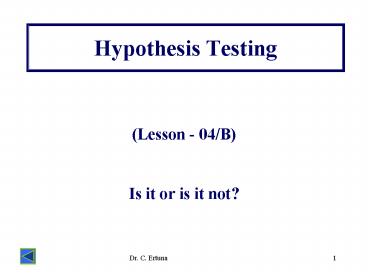Hypothesis Testing PowerPoint PPT Presentation
1 / 16
Title: Hypothesis Testing
1
Hypothesis Testing
- (Lesson - 04/B)
- Is it or is it not?
2
Chapter Outcomes
- After studying the material in this chapter, you
should be able to - Formulate null and alternative hypotheses for
applications involving a single population
mean, variance, or proportion. - Correctly formulate a decision rule for testing
a null hypothesis. - Know how to use the p-value, test statistic, and
critical value, approach to test the null
hypothesis.
3
Hypothesis Testing
- The hypothesis testing is testing a plausible
answer (proposition hypothesis) to a question by
expressing it in two contradicting propositions
(hypothesis) The null hypothesis (H0) and the
alternative hypothesis (HA). - How long does it take to process a guest at the
front desk? - H0 Processing a guest at the front desk takes 3
minutes or less. - HA Processing a guest at the front desk does not
take 3 minutes or less.
4
Formulating the Hypothesis
- The null hypothesis is a statement about the
population value that will be tested. - H0 Processing a guest at the front desk takes 3
minutes or less. - The null hypothesis will be rejected only if the
sample data provide substantial contradictory
evidence.
5
Formulating the Hypothesis
- The alternative hypothesis is the hypothesis that
includes all population values not covered by the
null hypothesis. - HA Processing a guest at the front desk does not
take 3 minutes or less. - The alternative hypothesis is deemed to be true
if the null hypothesis is rejected.
6
Hypothesis Set-up
- Ready to use statistical tests have their Ho
already set up. - For example
- for Normality test Ho series are normally
distributed - for Correlation test Ho there is no
relationship between the series. - In case of tests for special problems we need to
set up the Null Hypothesis using some general
rules.
7
Hypothesis Set-up
- To set-up a Null Hypothesis there are three rules
with the following order - Burden of Prove should be with the claim, (so,
claims should be expressed as Ha, since Ho
is harder to reject) - In general what is important should be expressed
as Ha (Statement of Claim, Investigation,
Expectation, etc.) - Use Common Sense,
- Have a positive approach.
8
Hypothesis Set-up (cont.)
- Example-1
- New has the burden of prove since it has
inherent claim that it is more efficient or
effective than the old. - new process - old process
- new drug - old drug
- new machine - old machine
9
Hypothesis Set-up (cont.)
- Exampl-2
- Management/Company has burden of proof since it
has power to make false claims - Claim on the performance of an employee
- (employee protection)
- Claim on the performance of a product
- (consumer protection)
10
Hypothesis Set-up (cont.)
- Exampl-3
- Government has burden of proof since it has
power to make false claims - Claim on violation of a low
11
Types of Statistical Errors
- Type I Error - This type of statistical error
occurs when the null hypothesis is true and is
rejected. - Type II Error - This type of statistical error
occurs when the null hypothesis is false and is
not rejected.
12
Types of Statistical Errors
13
Establishing the Decision Rule
- The job of the decision maker is to establish a
cutoff point, called a critical value. - The cutoff point is the demarcation between
failing to reject and rejecting the null
hypothesis. - When critical value is stated in terms of the
hypothesized mean it is labeled ?0.
14
Establishing the Decision Rule
- The critical value is the value of a statistic
corresponding to a given significance level.
This cutoff value determines the boundary between
the samples resulting in a test statistic that
leads to rejecting the null hypothesis and those
that lead to a decision not to reject the null
hypothesis.
15
Establishing the Decision Rule
- The significance level is the maximum probability
of committing a Type I statistical error. The
probability is denoted by the symbol ?.
16
Next Lesson
- (Lesson - 04/C)
- Statistical Decision and
- 1-Sample Hypothesis Testing

